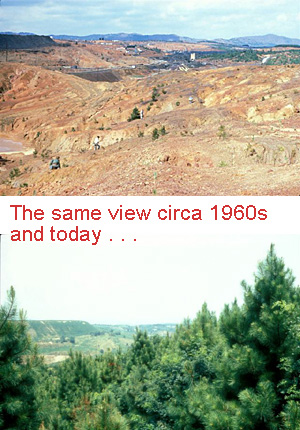|
The Copperhill Story

 GOOD NEWS!! My novel, A BIRD ON WATER STREET will be released by Little Pickle Press in Spring 2014. Please sign up for e's news (CLICK HERE) to receive updates. (Click the cover for more information.)
GOOD NEWS!! My novel, A BIRD ON WATER STREET will be released by Little Pickle Press in Spring 2014. Please sign up for e's news (CLICK HERE) to receive updates. (Click the cover for more information.)
Update! The new, illustrated (by me) edition of A BIRD ON WATER STREET is now available from Sourcebooks (2019).
While “A Bird on Water Street” is fiction, Jack’s story weaves through a real time and place in American history. Copperhill, Tennessee (New Cornwall) is located where Georgia, Tennessee, and North Carolina meet at the base of the Appalachian Mountains. (The town is called McCaysville on the Georgia side.) The Georgia, Tennessee line really does cut through the parking lot of the local IGA grocery store, and I’ve
stood with a foot in each state many times.
Copper was discovered there in the early 1840’s not long after the Cherokee Indians were forced out on the “Trail of Tears.” Tin
miners were brought in from Cornwall, England and other countries to apply
their expertise to copper mining.

Life was crazier than the wild west in those days. The remote area was cut off from most civilization by rocky terrain and terrible roads. Before the railroad, wagons (pulled by teams of oxen or donkeys) typically took weeks to haul supplies and copper in and out of the mountains. Therefore, miners turned to what seemed like an endless supply of locally available fuel to keep the smelters running wood.
By the 1870’s over 50 square miles of land had been stripped completely bare
of trees. All the remaining vegetation was killed by the toxic fumes expelled
from the open roasting pits and acid rain. Although the smelters were enclosed
in 1904 to trap and produce sulfuric acid, the area remained completely devoid
of vegetation for over a hundred years.

During my research, I heard amazing stories of what it was like to grow
up in such a strange environment. For instance, the wind was too corrosive
for tin roofs (everybody had asphalt shingles) and could eat up a pair of
nylon stockings hanging on a clothesline in a matter of minutes. 
The Environmental Protection Agency (EPA) did eventually put limits on
the amount of toxins allowed to seep out of the sulfuric acid plant, but some
levels were still permitted and the regulations were often ignored.
There wasn’t much citizens could do about it. The entire town’s economy relied
upon the Company, from the mines, to the grocery store, to the schools.
In the 1930s efforts to re-vegetate the 32,000 acre area began, although by then it was an uphill battle. Tree planting efforts continued through President Franklin D. Roosevelt’s Civilian Conservation Corps (the CCC) in the 1940s, and aerial seeding in the 1980s. Even with all the environmental efforts, the region didn’t start making a comeback until the early 1990’s. 
By the time my husband and I moved there in 2001, most of the area had
been reforested with pine trees which are quick growers and prevent erosion
(eventually, hardwoods will move in as well). However, signs of the previous
damage is still visible in some places, especially around the tailings ponds.
Local universities continue to experiment with various methods of environmental
reclamation, and have discovered that reeds and grasses work well as a natural
filtration process. Ironically, much of the once polluted area is now wetlands
and wildlife is slowly returning, even frogs.
Copperhill experienced a small boon in 1996 when the Olympic White Water
Competitions were held downstream on the Ocoee (Tohachee) River. It was a
shining moment for the residents and changed the focus of the town which now
relies on tourist dollars to survive. Visitors enjoy the scenic railway, the
vacation log cabins, and what is now a beautiful vista. 
The complicated history of the region is preserved at the Ducktown Basin Museum where visitors can see shocking photos of the once denuded landscape and schedule tours of the tailings ponds to observe reclamation efforts first hand.




Links to more amazing photos:
EPA - historic photos
EPA - more recent images
Glenn Springs Holding Company Photographs
(the company in charge of the clean-up)
|
